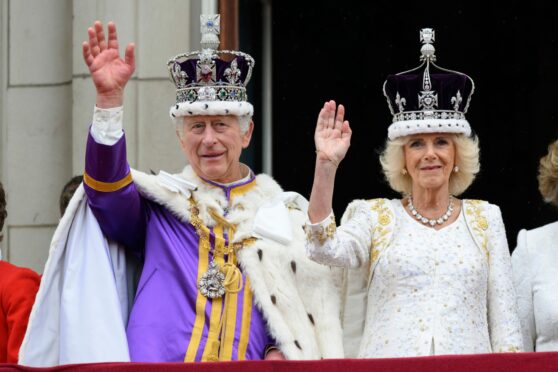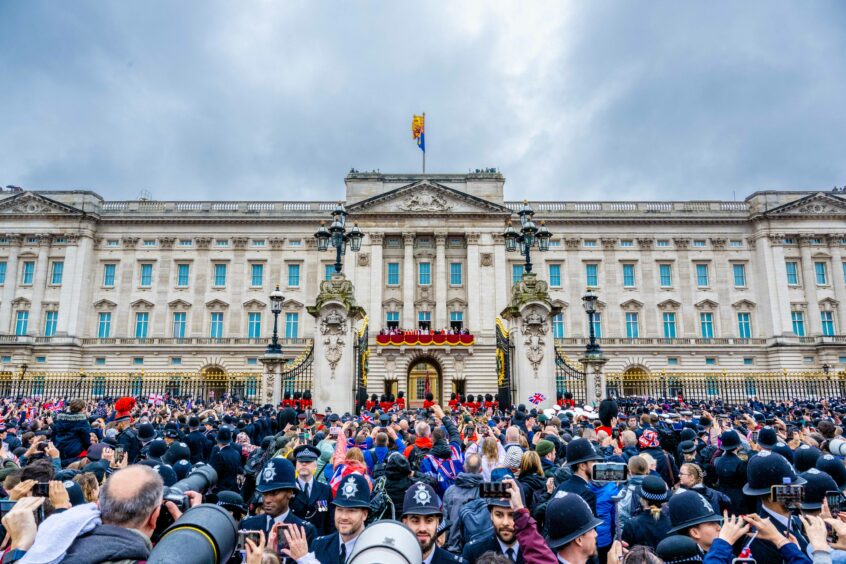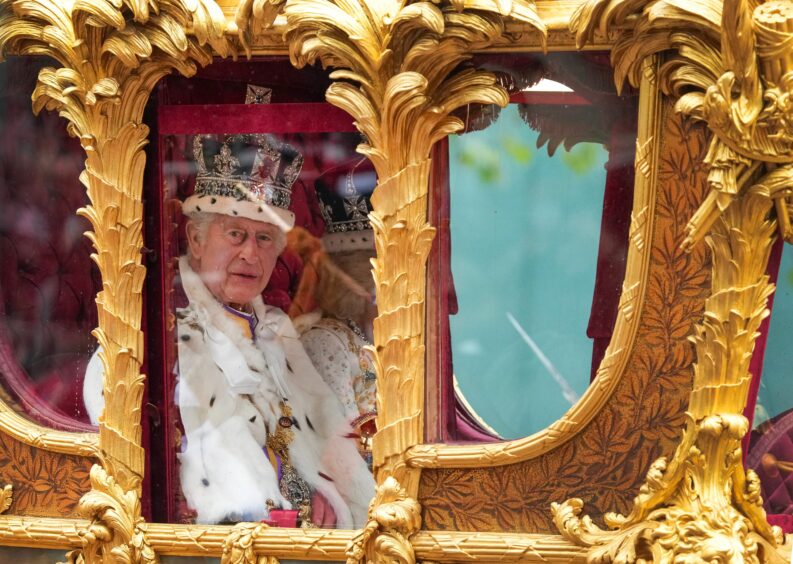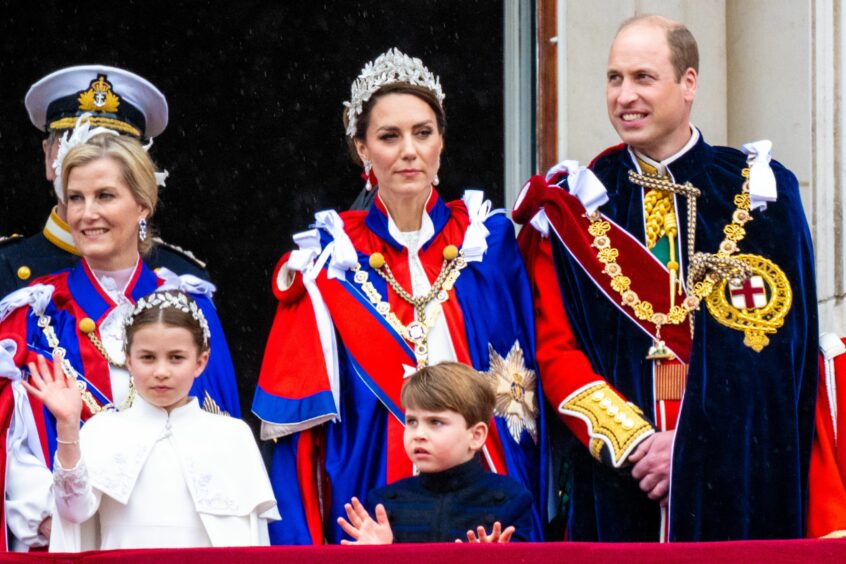
Waving out to the crowd from the Buckingham Palace balcony, the now crowned King Charles III was allowed a moment to take in a day that he had been preparing for all his life.
All but the weather had gone as planned in a day of pomp and ceremony, which began not long after the sun rose somewhere behind the rain clouds above London.
Almost eight months since making a similar journey to bid farewell to his mother, the King and Queen departed Buckingham Palace for Westminster Abbey in the Diamond Jubilee State Coach just after 10.20am.
Unperturbed by the rain, and in contrast to the solemn scenes of last September, crowds on either side of The Mall, many of whom had camped overnight, cheered as the procession passed.
Doors had opened at the Abbey at 7.30am, with over 2,200 people from 203 countries attending.
World leaders included Canada’s Justin Trudeau, while the US was represented by First Lady Jill Biden and granddaughter Finnegan.
Rishi Sunak and his wife were joined by their Downing Street predecessors and Humza Yousaf, wearing a kilt, was in attendance with his wife.
Star guests at the coronation included Lord Andrew Lloyd-Webber, who composed music for the event, Dame Emma Thompson, TV presenters Ant and Dec, and US singers Katy Perry and Lionel Richie, who will perform at tonight’s coronation concert.
The Prince and Princess of Wales entered the abbey last, and shared the front-row seats with fellow royals. Princess Charlotte and Prince Louis sat between their parents.
Prince Harry was in the third row, his wife Meghan and their two children not in attendance.
Also in a less prominent seat was Prince Andrew, who was met with boos from the crowds as he was driven down The Mall. He had no formal role in the coronation, having been stripped of his HRH title in 2022.
Charles was greeted by 14-year-old chorister Samuel Strachan. Prince George carried a corner of his grandfather’s trailing robes as the royal party made its way along the aisle.
The ceremony, lasting just under two hours, began at 11am, punctuated with music selected by the King, including 12 commissioned pieces, the first Welsh language piece to feature at a coronation, and Greek Orthodox music in memory of Prince Philip.
In a tradition dating back to Anglo-Saxon times, he was presented to the four sides of the abbey and proclaimed the “undoubted King”.
Archbishop of Canterbury Justin Welby administered the Coronation Oath, before the King’s Robe of State was removed and he was left wearing a simple white shirt for the anointing.
The anointing with special oil in the form of a cross on his head, breast and hands is considered the most sacred part of the service, and a screen was put up to conceal him from view amid a rousing rendition of Handel’s Zadok the Priest.
Charles was finally crowned in the investiture. Placed upon him was a shimmering golden coat, the Supertunica, and he was presented with regalia including the Sovereign’s Orb and the Coronation Ring.
He gave a small smile to his older son as William approached to clothe him with the Stole Royal – a golden priestly scarf.
As the clock struck 12.01, Welby placed St Edward’s Crown on Charles’ head – the only time he will ever wear it. Trumpets played, the abbey bells rang and gun salutes were fired across the UK, including Edinburgh.
Charles then took to the throne. As part of a streamlined service, William was the only Royal Duke to have to kneel and pay homage. Welby invited people in the abbey and watching at home to pledge their own allegiances.
Camilla then went through her own, slightly simpler ceremony. She did not, however, have to take an oath. The final part of the service saw the King and Queen take Holy Communion.
While primarily a Christian service, efforts were made to make it multi-faith and diverse, with representatives from Muslim, Jewish, Sikh and Buddhist communities.
The prime minister, a Hindu, was among those addressing the ceremony, reading the Epistle to the Colossians, from the New Testament and, for the first time, female bishops were involved.
After the ceremony, the King and Queen returned to Buckingham Palace along the reverse of the route by which they came, this time in the 260-year-old Gold State Coach.
The Princess Royal was among those riding on horseback behind the coach as nearly 4,000 members of the armed forces took part in the largest ceremonial operation of its kind for a generation.
Then came the part most had been waiting for, the traditional appearance on the Buckingham Palace balcony, joined by the working royals and children.
The day’s public ceremonies came to a close with a fly-past, shortened by the weather, featuring helicopters and the Red Arrows, and then an encore appearance on the balcony.
Ahead of the parades, members of Just Stop Oil and anti-monarchist protest group Republic were among a number of people arrested in London.
Police were criticised for their crackdown on dissent, with the coronation taking place just days after the controversial new Public Order Act came into force.
Republic shared images online of the arrests, tweeting: “So much for the right to peaceful protest.”
No supporters of Just Stop Oil arrested in the crowd had glue, paint or any plans to disrupt the Coronation.
New policing laws mean we're now living in a dystopian nightmare – this disgraceful overreach is what you'd expect in Pyongyang, North Korea, not Westminster. pic.twitter.com/kJPWBn4Pvz
— Just Stop Oil (@JustStop_Oil) May 6, 2023
The Met had said earlier in the week that they would have an “extremely low threshold”
for any protest action, and that those involved should expect “swift action”.
Campaign group Human Rights Watch said the coronation arrests were “something you would expect to see in Moscow not London”.
Alastair Campbell tweeted: “This is totally at odds with the British values of which we will be hearing a huge amount today. It’s what happens when the police take their lead from political messaging.”

Enjoy the convenience of having The Sunday Post delivered as a digital ePaper straight to your smartphone, tablet or computer.
Subscribe for only £5.49 a month and enjoy all the benefits of the printed paper as a digital replica.
Subscribe © Shutterstock
© Shutterstock © Canadian Press/Shutterstock
© Canadian Press/Shutterstock  © Shutterstock
© Shutterstock